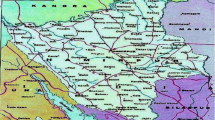Abstract
Indoor radon has been recognized as one of the health hazards for mankind. Common building materials used for construction of houses, which are considered as one of the major sources of this gas in indoor environment, have been studied for exhalation rate of radon. Non-nuclear industries, such as coal fired power plants or fertilizer production facilities, generate large amounts of waste gypsum as by-products. Compared to other building materials waste gypsum from fertilizer production facilities (phosphogypsum) shows increased rates of radon exhalation. In the present, investigation solid state alpha track detectors, CR-39 plastic detectors, were used to measure the indoor radon concentration and the radon exhalation rates from some building materials used in Egypt. The indoor radon concentration and the radon exhalation rate ranges were found to be 24–55 Bq m−3 and 11–223 mBq m−2 h−1, respectively. The effective dose equivalent range for the indoor was found 0.6–1.4 mSv y−1. The equilibrium factor between radon and its daughters increased with the increase of relative humidity.
Similar content being viewed by others
References
Ashraf FA. 2003 Experimental and theoretical evaluation for radon gas levels in environment. PhD Thesis, Cairo University
GE Clamp J Pritchard (1998) ArticleTitleInvestigation of fault position and sources of radon by measurement of 238U decay series radionuclide activity in soil samples Environ Geochem Health 20 IssueID1 39–44 Occurrence Handle10.1023/A:1006525800379
Denman AR, Barker SP, Parkinson S, Marley F, Phillips PS. 1999 Do the UK workplace radon action levels reflect the radiation dose received by the occupants? Radiol Protection J, 37–43.
MH Magalhoes ECS Amaral I Sachett ERR Rocheda (2003) ArticleTitleRadon−222 in Brazil: an outline of indoor and outdoor measurements J Environ Radioact 67 IssueID2 131–143 Occurrence Handle10.1016/S0265-931X(02)00175-3
AF Maged T Tsuruta SA Durrani (1993) ArticleTitleExperimental and theoretical consideration on the calibration factor between a activity concentration and track density for application in radon dosimetry J Radioanal and Nucl Chem 170 IssueID2 423 Occurrence Handle10.1007/BF02041478
AF Maged FA Ashraf AZ El-Behay (1997) ArticleTitleRadon levels measured at building sites and in sub-soil in Delta Radiat Meas 28 IssueID1–6 599–602 Occurrence Handle10.1016/S1350-4487(97)00148-0
AF Maged GM Mokhtar MM El-Tobgwi AA Gabbr NI Attia MM Abu shady (2000) ArticleTitleDomestic radon concentration and childhood cancer study in Cairo, Egypt Environ Carcino & Ecotox Revs C18 IssueID2 153–170
AF Maged EA Saad (1998) ArticleTitleRadon exhalation rate from some fertilizers, clay and potatoes in Egypt J Environ Manage Health 9 IssueID2 & 3 130 Occurrence Handle10.1108/09566169810222210
R Mustonen (1984) ArticleTitleNatural radioactivity in and radon exhalation from Finnish building materials Health Phys 46 1195
H Papaefthymion A Mavroudis P Kritidis (2003) ArticleTitleIndoor radon levels and influencing factors in houses of Patras Greece J Environ Radioact 66 IssueID3 247–260 Occurrence Handle10.1016/S0265-931X(02)00110-8
Results of the 1997 European Commission Intercomparison of Passive Radon Detectors. 1998 EUR 18835 EN
N Sharma HS Virk (2001) ArticleTitleExhalation rate study of radon/thoron in some building materials Radiat Measure 34 IssueID1–6 467–469 Occurrence Handle10.1016/S1350-4487(01)00208-6
H Stigum T Strand P Maguus (2003) ArticleTitleShould radon be reduced in homes? A cost-effect analysis Health Phys 84 IssueID3 227–235 Occurrence Handle10.1097/00004032-200302000-00011
E Stranden AK Kolsted B Lind (1984) ArticleTitleThe influence of moisture and temperature on radon exhalation Radiat Prot Dosim 7 IssueID1–4 55–58
Tanner AB. 1978 Radon migration in the ground: a supplement review. In eds Gessell TF, Lower WM, eds. Natural Radiation Environment III, US Dept of Energy Rep.(ONF-780422, Spring field, VA: NTIS) pp.5–56
UNSCEAR, United Nations Scientific Committee on the Effects of Atomic Radiation. 1993 Report to the General Assembly, with Scientific annexes, United Nations Sales Publication E.94.1X.2. United Nations, New York, (1993)
RL Watters WR Hansen (1979) ArticleTitleThe hazard implication of the transfer of unsupported Po−210 from alkaline soil to plants Health Phys 18 409 Occurrence Handle10.1097/00004032-197004000-00012
Weast RC. 1969 CRC Handbook of Chemistry and Physics A Ready-Reference Book of Chemical and Physical Data, 49th edn. The Chemical Rubber Co., 18901 Granwood Parkway, Cleveland, Ohio, 44128
Author information
Authors and Affiliations
Corresponding author
Rights and permissions
About this article
Cite this article
Maged, A., Ashraf, F. Radon Exhalation Rate of Some Building Materials Used in Egypt. Environ Geochem Health 27, 485–489 (2005). https://doi.org/10.1007/s10653-005-5332-5
Received:
Accepted:
Issue Date:
DOI: https://doi.org/10.1007/s10653-005-5332-5




